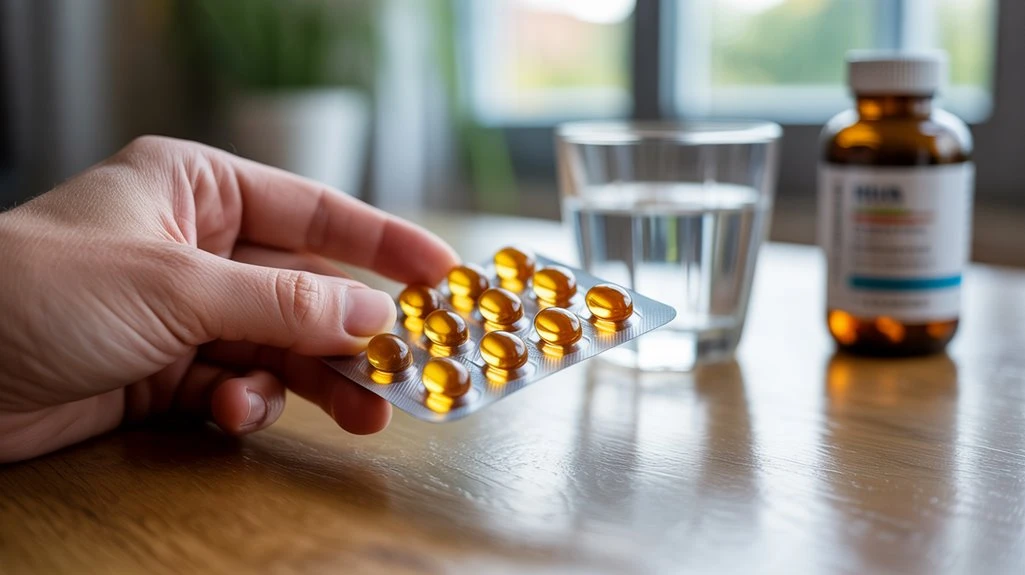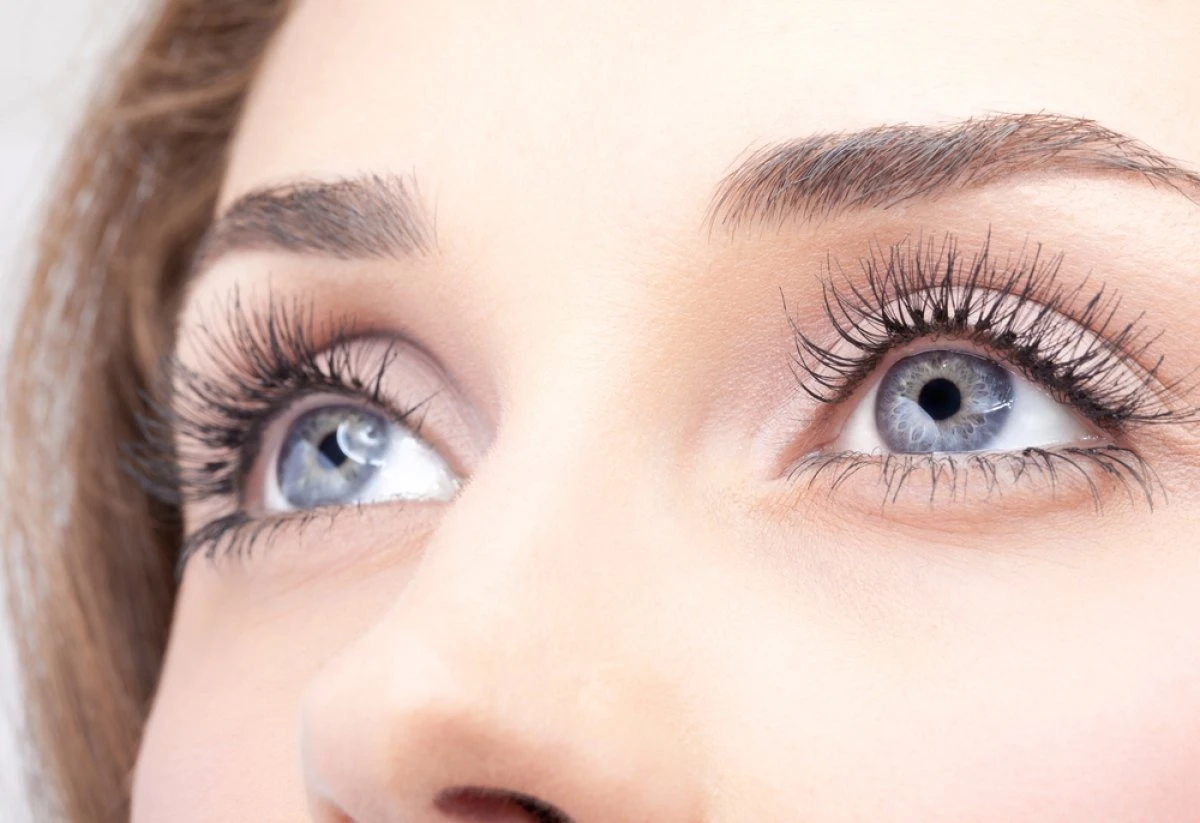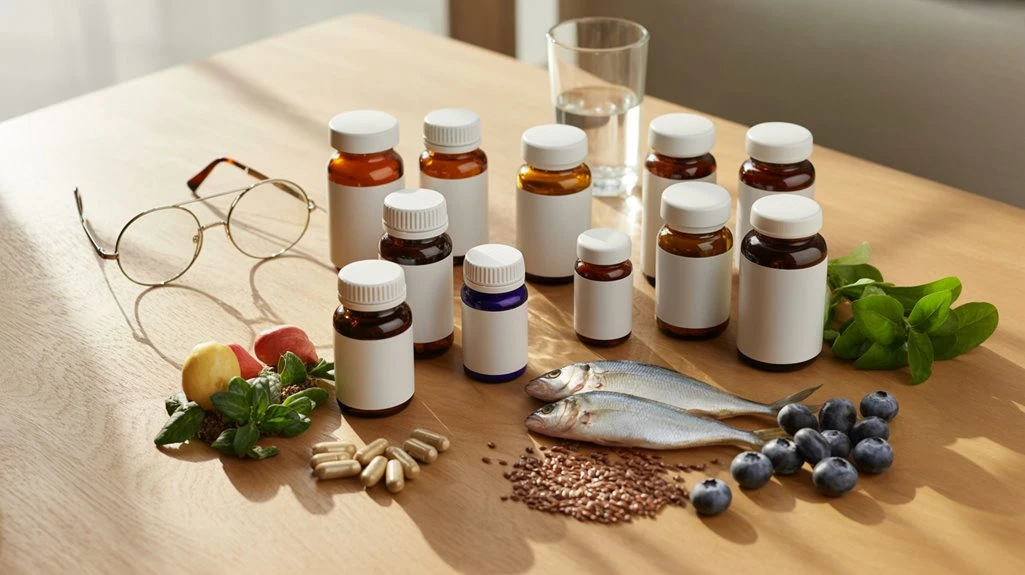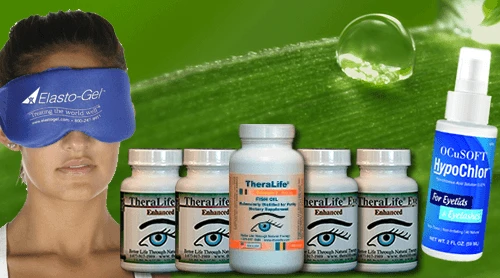If you’re looking for effective relief from dry eyes, TheraLife offers a unique solution. Unlike other products on the market, TheraLife is the only company providing oral eye treatment care, specifically designed to support tear film stability and ocular surface integrity. Their products benefit customers by addressing the root causes of dry eyes, offering a comprehensive approach that includes nutrients like omega-3 fish oil, flaxseed oil, and gamma-linolenic acid (GLA) from sources such as borage or black currant seed oil.
TheraLife’s oral supplements are backed by clinical studies to ensure safety and effectiveness. They offer a natural treatment for conditions like blepharitis and uveitis, and provide guidance on lifestyle and dietary changes to enhance eye health. Customers can also find tips on managing other related issues, such as eye discharge in babies and the impact of eyelash extensions on dry eyes. With a focus on holistic care, TheraLife stands out as a leader in providing solutions for dry eye sufferers.
Best Oral Dry Eyes Treatment That Works With Contact Lenses.
Add To Cart
Key Takeaways For Dry Eyes
- Flaxseed oil softgels provide plant-based omega-3s to stabilize tears and reduce ocular inflammation for dry eye relief.
- GLA supplements, from sources like borage or black currant seed oil, support tear film stability and meibomian gland function.
- Vitamin A tablets enhance ocular surface health, mucin production, and reduce dryness symptoms in deficient individuals.
- Astaxanthin antioxidant pills combat oxidative stress, protecting tear glands and improving tear film stability in dry eye sufferers.
- Lutein and zeaxanthin complexes offer antioxidant benefits, supporting macular health and reducing inflammation associated with dry eyes.
Omega-3 Fish Oil Capsules- For Dry Eyes

Omega-3 fish oil capsules are frequently promoted as a remedy for dry eye syndrome, but current clinical evidence doesn’t support their efficacy for this indication. Despite popular claims regarding omega 3 benefits, randomized controlled trials and systematic reviews haven’t demonstrated a significant improvement in dry eye symptoms or objective clinical markers when you supplement with fish oil. The DREAM study, a landmark multicenter trial, found no statistical difference between omega-3 supplementation and placebo in alleviating dry eye disease. You may encounter marketing suggesting that fish oil is essential for ocular surface health, but rigorous evaluation doesn’t confirm this. Omega-3 supplements may interact with blood clotting medications, posing potential risks. While omega 3 benefits include cardiovascular and anti-inflammatory effects, you shouldn’t rely on fish oil capsules as an evidence-based intervention for dry eye syndrome. Always consult your eye care professional for tailored recommendations.
Flaxseed Oil Softgels For Dry Eyes
You’ll find that flaxseed oil softgels offer a plant-based source of alpha-linolenic acid, an essential omega-3 fatty acid linked to improved tear film stability. Clinical studies indicate their anti-inflammatory properties may help alleviate ocular surface irritation in dry eye disease. It’s important to evaluate evidence-based dosage recommendations and monitor for potential gastrointestinal or bleeding risks. For those suffering from chronic dry eyes, TheraLife Eye capsules have shown to effectively address underlying tear production issues and provide substantial relief.
Omega-3 Fatty Acids For Dry Eyes
Although numerous supplements claim to alleviate dry eye symptoms, flaxseed oil softgels have gained attention due to their high content of alpha-linolenic acid (ALA), a plant-based omega-3 fatty acid.
When you incorporate these softgels into your regimen, you’re providing your body with essential fatty acids that support overall eye health.
Clinical studies indicate that omega-3 supplementation, particularly ALA from flaxseed oil, can help stabilize the tear film and improve ocular surface integrity. This effect may contribute to inflammation reduction, a key factor in managing chronic dry eye.
By enhancing the lipid layer of your tears, flaxseed oil softgels support tear stability and decrease evaporative loss.
For individuals seeking a plant-derived option, these softgels offer a clinically relevant approach to dry eye management.
Incorporating omega-3 sources like these softgels can also aid in preventing macular degeneration, an important aspect of maintaining overall eye health.
Anti-Inflammatory Benefits
While flaxseed oil softgels are often promoted for their potential anti-inflammatory properties, current clinical evidence doesn’t robustly support a significant reduction in ocular surface inflammation from ALA supplementation alone. You’ll find that α-linolenic acid (ALA), the primary omega-3 in flaxseed oil, is frequently included in discussions of natural remedies for dry eye disease. However, peer-reviewed studies consistently demonstrate that ALA’s conversion to longer-chain omega-3s, such as EPA and DHA, is limited in humans. This metabolic inefficiency may explain the lack of measurable anti-inflammatory benefits in clinical trials evaluating ocular surface markers. If you’re seeking natural remedies for dry eye, it’s essential to understand that flaxseed oil softgels may not provide the robust anti-inflammatory properties often attributed to them in marketing claims. It is important to note that some alternative treatments like fish oil supplements, which contain EPA and DHA, may support tear production and eye health.
Dosage and Safety
When considering flaxseed oil softgels for dry eye management, it’s critical to evaluate both appropriate dosage and safety parameters. Evidence-based dosage guidelines typically recommend 1,000–2,000 mg daily, divided into one or two doses. Always adhere to the product’s label or your ophthalmologist’s recommendations to optimize efficacy and minimize adverse effects. Safety precautions are paramount: flaxseed oil may interact with anticoagulant or antiplatelet medications, increasing bleeding risk. Gastrointestinal symptoms, such as bloating or diarrhea, may occur at higher dosages. If you’re pregnant, nursing, or have chronic health conditions, consult your healthcare provider before initiation. Conditions like meibomian gland dysfunction can contribute to dry eye symptoms, making it important to consider comprehensive management strategies.
| Dosage Guidelines | Safety Precautions |
|---|---|
| 1,000–2,000 mg daily | Monitor for GI symptoms |
| Divide doses | Avoid with blood thinners |
| Follow medical advice | Consult provider if pregnant/nursing |
Evening Primrose Oil Supplements For Dry Eyes
Despite its popularity in alternative medicine, evening primrose oil lacks robust clinical evidence supporting its efficacy for dry eye disease. You may encounter claims that gamma-linolenic acid (GLA), a key component in evening primrose, can alleviate ocular surface inflammation, but controlled trials haven’t consistently demonstrated significant improvement in tear production or symptom relief for dry eye patients. Most studies on evening primrose focus on its potential benefits for skin health, such as atopic dermatitis, rather than ophthalmic conditions. If you’re considering evening primrose supplements, be aware that the current literature doesn’t support their routine use for dry eye management. Instead, prioritize interventions with established clinical backing and always consult an eye care professional before starting any new supplement regimen for ocular surface disease. Dry eye disease can have significant discomfort leading to diminished quality of life, emphasizing the importance of seeking out well-researched treatment options.
Vitamin A Tablets For Dry Eyes

Vitamin A plays a critical role in maintaining the health of the ocular surface and supporting normal tear film production. If you’re managing dry eye symptoms, Vitamin A tablets can be a valuable addition to your regimen.
Clinical studies demonstrate that Vitamin A deficiency is associated with xerophthalmia, decreased mucin production, and compromised epithelial integrity—all factors contributing to dry eye disease. Supplementing with Vitamin A supports epithelial cell differentiation and enhances mucous secretion, stabilizing the tear film and promoting ideal eye health.
Vitamin A benefits extend to reducing ocular surface inflammation and improving the function of conjunctival goblet cells. When you choose Vitamin A tablets, you’re investing in a supplement that’s backed by robust evidence for supporting eye health and mitigating the discomfort linked to inadequate tear production. Unlike topical products, oral formulation such as TheraLife Eye targets the root causes of dry eye from within the body.
Always consult your eye care professional before starting supplementation.
Vitamin D3 Capsules For Dry Eyes
Deficiency in Vitamin D3 is increasingly recognized as a contributing factor in both the development and persistence of dry eye disease.
When you lack sufficient Vitamin D3, it can disrupt the function of the lacrimal glands and compromise the tear film’s stability, leading to ocular surface inflammation.
Clinical studies suggest that Vitamin D3 benefits include modulation of immune responses and enhancement of epithelial barrier integrity, both essential for ideal eye health.
Supplementing with Vitamin D3 capsules may help restore normal tear secretion, reduce ocular discomfort, and lower inflammatory cytokine levels.
If you’re experiencing persistent dry eye symptoms, evaluating your Vitamin D3 status is recommended.
Targeted supplementation is a practical, evidence-based approach to supporting your overall eye health and improving the quality of your vision.
A Leader in Chronic Dry Eye Relief, TheraLife Eye targets the root cause of dry eyes, aiming to restore natural tear production and reduce inflammation.
GLA (Gamma-Linolenic Acid) Supplements For Dry Eyes
Addressing ocular inflammation and tear film instability extends beyond micronutrients alone; targeted fatty acids like Gamma-Linolenic Acid (GLA) offer additional therapeutic value for dry eye management.
You’ll find GLA in several plant-based sources, with evening primrose oil, borage seed oil, and black currant seed oil being the primary GLA sources recommended for supplementation.
Clinical studies demonstrate that GLA benefits individuals with dry eye by modulating inflammatory pathways, particularly through the conversion to anti-inflammatory prostaglandins. This mechanism helps stabilize tear film and reduce ocular surface irritation.
When you incorporate GLA supplements into your regimen, you’re supporting both the lipid layer and meibomian gland function, vital elements in maintaining ocular surface health.
Autoimmune diseases involve self-attack on healthy tissues, and managing inflammation through diet and supplements like GLA can be crucial for maintaining eye health.
Always select standardized GLA sources to guarantee potency and consult with an eye care professional before starting supplementation.
Astaxanthin Antioxidant Pills For Dry Eyes

As a potent xanthophyll carotenoid, astaxanthin has attracted attention for its robust antioxidant properties and potential role in ocular surface protection.
When you supplement with astaxanthin antioxidant pills, you leverage its ability to neutralize reactive oxygen species implicated in dry eye pathogenesis. Clinical studies suggest astaxanthin benefits include reduced oxidative stress in lacrimal glands and improved tear film stability, supporting healthier epithelial cell function.
Typical astaxanthin sources are microalgae (Haematococcus pluvialis), but you’ll also find it in marine organisms like salmon, shrimp, and krill. For therapeutic use, concentrated oral supplements offer a standardized dose, enhancing efficacy.
While astaxanthin is generally safe, consult your eye care professional to guarantee ideal dosing and integration with other dry eye therapies. Preservative-free formulations of glaucoma medications have shown improved tolerability, which can be beneficial for those managing both dry eye disease and glaucoma.
Lutein and Zeaxanthin Complex or Dry Eyes
Although lutein and zeaxanthin are best known for their role in macular health, mounting research highlights their importance in maintaining ocular surface integrity and combating dry eye symptoms.
These carotenoids exhibit potent antioxidant properties, reducing oxidative stress and inflammation on the ocular surface. By neutralizing free radicals, they help preserve tear film stability and epithelial cell health.
You can obtain lutein from sources like leafy green vegetables, egg yolks, and dietary supplements, ensuring maximal intake for ocular surface protection.
Zeaxanthin benefits extend to enhanced tear secretion and improved goblet cell density, both critical for alleviating dry eye discomfort.
Clinical trials demonstrate that supplementation with a lutein and zeaxanthin complex may markedly decrease dry eye signs and improve overall ocular comfort and function.
Hyaluronic Acid Oral Supplements
You may consider hyaluronic acid oral supplements to enhance ocular surface hydration and support tear film stability.
Clinical evidence shows these supplements can alleviate dryness by promoting mucin production and improving tear quality.
For ideal absorption and efficacy, you’ll want to follow evidence-based dosing guidelines.
Hydration for Eye Comfort
While hyaluronic acid is well-established in ophthalmic formulations for topical eye hydration, evidence supporting the efficacy of oral hyaluronic acid supplements for dry eye relief remains insufficient.
You may find topical hyaluronic acid drops beneficial for stabilizing the tear film and enhancing ocular surface moisture, yet oral supplementation hasn’t demonstrated comparable effectiveness in clinical trials.
If you’re seeking comfort strategies for dry eyes, it’s essential to prioritize interventions with substantiated outcomes. Clinical data suggest that maintaining systemic hydration, optimizing environmental conditions, and using artificial tears should be your primary approaches.
Oral hyaluronic acid’s low bioavailability and limited direct ocular absorption make it less reliable for improving eye hydration.
Always evaluate supplement claims critically and discuss any regimen with your eye care professional to guarantee evidence-based, safe choices.
Supporting Tear Production
Despite growing interest in oral hyaluronic acid supplements for supporting tear production, current clinical evidence doesn’t validate their efficacy for dry eye management.
You might encounter claims that oral hyaluronic acid improves tear film stability and enhances ocular health, but robust randomized controlled trials remain lacking.
The mechanisms by which systemic supplementation could affect the lacrimal glands or increase aqueous tear secretion aren’t well established.
Topical hyaluronic acid does show benefit in ocular surface lubrication, yet oral administration hasn’t demonstrated significant impact on tear volume or quality in peer-reviewed studies.
If you’re considering oral hyaluronic acid for dry eye, it’s crucial to recognize that, at this time, supporting tear film and overall ocular health with this supplement isn’t substantiated by current scientific data.
Absorption and Dosage Tips
Given the limited clinical validation for oral hyaluronic acid in dry eye management, it’s important to understand how absorption and dosage influence potential outcomes. Oral hyaluronic acid’s bioavailability is modest, as large molecules are only partially absorbed in the gastrointestinal tract. To improve absorption, you should select low molecular weight formulations and take them with water, away from meals. Typical dosage recommendations range from 120 mg to 240 mg daily, though specific needs may vary. Always consult your eye care provider before adjusting supplements, as evidence-based guidelines are evolving. The table below summarizes practical absorption methods and dosage recommendations for peak efficacy.
| Absorption Methods | Dosage Recommendations |
|---|---|
| Low molecular weight forms | 120–240 mg daily |
| Taken with water | Split dose (morning/evening) |
| Empty stomach | Consult provider |
| Consistent timing | Monitor for effects |
| Avoid high-fat meals | Adjust as advised |
Bilberry Extract Capsules
Bilberry extract capsules often appear in discussions about ocular health due to the fruit’s rich anthocyanin content, which has antioxidant properties.
You’ll find that bilberry benefits stem from these potent compounds that may support retinal function and capillary integrity—both essential for ideal eye health.
Clinically, anthocyanins are thought to mitigate oxidative stress and inflammation, factors implicated in dry eye syndrome. Some studies suggest bilberry supplementation can enhance tear secretion and reduce eye fatigue, though more robust, randomized trials are necessary to confirm efficacy for dry eye specifically.
When considering bilberry extract, verify standardized dosages and consult your ophthalmologist, particularly if you have underlying conditions or take anticoagulants.
Best Oral Dry Eye Treatment That Works With Contact Lenses.
Add To Cart
Frequently Asked Questions
Can Dry Eye Supplements Interact With Prescription Medications?
You should know that supplement interactions with prescription medications can occur, even with products aimed at dry eye relief.
Certain ingredients, such as omega-3 fatty acids or herbal extracts, may impact medication safety by altering drug metabolism or increasing bleeding risk.
Always consult your healthcare provider or pharmacist before starting any supplement, especially if you’re on anticoagulants, antihypertensives, or immunosuppressants, to guarantee evidence-based, clinically sound decisions and minimize adverse effects.
Are Dry Eye Supplements Safe for Pregnant or Breastfeeding Women?
If you’re pregnant or breastfeeding, always prioritize safety guidelines before taking any dry eye supplements.
Certain ingredients, like high-dose vitamin A or omega-3 fatty acids, may pose risks or lack sufficient safety data in these populations.
Consult your healthcare provider, who can evaluate ingredient considerations and potential contraindications based on current clinical evidence.
Don’t self-medicate—professional guidance guarantees both maternal and fetal safety while managing dry eye symptoms effectively.
How Long Does It Take to See Results From Dry Eye Supplements?
Imagine waking up to clearer, more comfortable eyes after weeks of gritty discomfort.
Typically, you’ll notice the effectiveness timeline for dry eye supplements ranges from four to twelve weeks. Individual variation plays a significant role—your response may differ based on baseline tear function, supplement formulation, and adherence.
Clinical evidence suggests omega-3 fatty acids and antioxidant blends require consistent intake before measurable improvement in tear film stability and ocular surface health becomes apparent.
Do Dry Eye Supplements Have Any Common Side Effects?
When you take dry eye supplements, you might experience mild side effects like gastrointestinal discomfort, especially if you exceed dosage recommendations.
Common ingredients such as omega-3 fatty acids, vitamin E, and flaxseed oil are generally safe, but they can sometimes cause diarrhea, nausea, or a fishy aftertaste.
It’s important that you follow evidence-based dosage guidelines and consult your ophthalmologist, particularly if you’re taking anticoagulants or have underlying medical conditions.
Can Children Take Dry Eye Supplements Safely?
Imagine your child complains of dry, irritated eyes. You might wonder if dry eye supplements are safe for kids.
While certain supplement ingredients like omega-3s have shown benefits in adults, children’s dosage isn’t well-established. Pediatric studies are limited, so you shouldn’t assume adult recommendations apply.
Always consult a pediatric ophthalmologist before starting any supplement, as children’s developing systems may react differently to ingredients or dosages considered safe for adults.
Best Oral Dry Eye Treatment That Works With Contact Lenses.
Add To Cart
Conclusion
Incorporating the right supplements into your daily regimen can make a notable difference in managing dry eye symptoms. TheraLife.com stands out as the only company providing oral eye treatment care, offering a unique approach to addressing dry eyes. Their products benefit customers by targeting inflammation and supporting tear film stability, effectively addressing the root causes of ocular surface disease. For instance, omega-3 supplementation has been shown to reduce dry eye discomfort significantly. TheraLife’s clinically proven nutrients, such as lutein, astaxanthin, and hyaluronic acid, are tailored to enhance eye health. Consult your ophthalmologist to determine which TheraLife evidence-based options best fit your individual needs for optimal eye health.
References
- 1.
- The definition and classification of dry eye disease: report of the Definition and Classification Subcommittee of the International Dry Eye WorkShop (2007). Ocul Surf. 2007 Apr;5(2):75-92. [PubMed]
- 2.
- Huang R, Su C, Fang L, Lu J, Chen J, Ding Y. Dry eye syndrome: comprehensive etiologies and recent clinical trials. Int Ophthalmol. 2022 Oct;42(10):3253-3272. [PMC free article] [PubMed]
- 3.
- Craig JP, Nichols KK, Akpek EK, Caffery B, Dua HS, Joo CK, Liu Z, Nelson JD, Nichols JJ, Tsubota K, Stapleton F. TFOS DEWS II Definition and Classification Report. Ocul Surf. 2017 Jul;15(3):276-283. [PubMed]
- 4.
- King-Smith PE, Fink BA, Hill RM, Koelling KW, Tiffany JM. The thickness of the tear film. Curr Eye Res. 2004 Oct-Nov;29(4-5):357-68. [PubMed]
- 5.
- King-Smith PE, Fink BA, Fogt N, Nichols KK, Hill RM, Wilson GS. The thickness of the human precorneal tear film: evidence from reflection spectra. Invest Ophthalmol Vis Sci. 2000 Oct;41(11):3348-59. [PubMed]
- 6.
- Chen Q, Wang J, Tao A, Shen M, Jiao S, Lu F. Ultrahigh-resolution measurement by optical coherence tomography of dynamic tear film changes on contact lenses. Invest Ophthalmol Vis Sci. 2010 Apr;51(4):1988-93. [PMC free article] [PubMed]
- 7.
- Willcox MDP, Argüeso P, Georgiev GA, Holopainen JM, Laurie GW, Millar TJ, Papas EB, Rolland JP, Schmidt TA, Stahl U, Suarez T, Subbaraman LN, Uçakhan OÖ, Jones L. TFOS DEWS II Tear Film Report. Ocul Surf. 2017 Jul;15(3):366-403. [PMC free article] [PubMed]
- 8.
- Peng CC, Cerretani C, Braun RJ, Radke CJ. Evaporation-driven instability of the precorneal tear film. Adv Colloid Interface Sci. 2014 Apr;206:250-64. [PubMed]
- 9.
- Zhou L, Beuerman RW. Tear analysis in ocular surface diseases. Prog Retin Eye Res. 2012 Nov;31(6):527-50. [PubMed]
- 10.
- Mantelli F, Mauris J, Argüeso P. The ocular surface epithelial barrier and other mechanisms of mucosal protection: from allergy to infectious diseases. Curr Opin Allergy Clin Immunol. 2013 Oct;13(5):563-8. [PMC free article] [PubMed]
- 11.
- O’Neil EC, Henderson M, Massaro-Giordano M, Bunya VY. Advances in dry eye disease treatment. Curr Opin Ophthalmol. 2019 May;30(3):166-178. [PMC free article] [PubMed]
- 12.
- Fjaervoll K, Fjaervoll H, Magno M, Nøland ST, Dartt DA, Vehof J, Utheim TP. Review on the possible pathophysiological mechanisms underlying visual display terminal-associated dry eye disease. Acta Ophthalmol. 2022 Dec;100(8):861-877. [PMC free article] [PubMed]
- 13.
- Craig JP, Nelson JD, Azar DT, Belmonte C, Bron AJ, Chauhan SK, de Paiva CS, Gomes JAP, Hammitt KM, Jones L, Nichols JJ, Nichols KK, Novack GD, Stapleton FJ, Willcox MDP, Wolffsohn JS, Sullivan DA. TFOS DEWS II Report Executive Summary. Ocul Surf. 2017 Oct;15(4):802-812. [PubMed]
- 14.
- Qian L, Wei W. Identified risk factors for dry eye syndrome: A systematic review and meta-analysis. PLoS One. 2022;17(8):e0271267. [PMC free article] [PubMed]





